The world of Formula 1 is on the brink of significant change, as leading power unit manufacturers and the FIA convened to discuss upcoming engine regulations set for 2026. In a pivotal meeting held in Bahrain, FIA President Mohammed Ben Sulayem steered the conversation towards mitigating a repeat of the dominance that Mercedes showcased in the 2014 season. The stakes are high; maintaining competitive balance is critical to keeping spectators engaged and the competition fierce.
This exploratory discussion was not just a formality; it underscored the urgency for a collective vision among manufacturers, including newly joining entities like Cadillac alongside established giants such as Audi and Honda. Thanks to modern communication technologies, leaders like Mercedes CEO Ola Kallenius participated from afar, demonstrating the global nature of these negotiations. The participation of a varied group of manufacturers indicated a collaborative spirit, yet it also illuminated differing priorities, particularly around the hybrid rules expected to revolutionize F1’s future.
Resistance to Change: The Stance on V10 Engines
The mention of reverting to V10 engines, introduced by President Sulayem, was met with skepticism. Both Audi and Honda were emphatic in their opposition, expressing that any alteration to the hybrid systems they had initially bought into would undermine their investments and strategies. As ever in Formula 1, the interplay of innovation and tradition creates substantial tension, revealing the delicate balance manufacturers must navigate between legacy performance and modern developments.
Christian Horner, team principal of Red Bull Racing, articulated the need for prudence. The consensus emerging from this meeting is clear: while the 2026 regulations remain fixed, the long-term trajectory of engine design still requires careful consideration. Each manufacturer brings different perspectives and capabilities, making the possibility of finding a universally acceptable direction a daunting challenge.
Performance Dilemmas: Lessons from the Past
Reflecting on the considerable performance imbalances witnessed in previous seasons, particularly during Mercedes’ reign, the manufacturers are keenly aware of the necessity for mechanisms that prevent similar outcomes. The 2014 season underscored that extreme shifts in regulations could easily lead to performance disparities—a reality that no stakeholder wishes to relive. The conversation in Bahrain sparked ideas around increased flexibility concerning engine upgrades during the season, a departure from the current model where designs must be homologated and frozen.
Horner boldly suggested that the financial constraints provided by the budget cap might offer a way to evolve engine design mid-season without chaos. With the aims of encouraging manufacturers to converge on performance levels and, as a result, promote more riveting racing, this dialogue is not merely theoretical. It taps into the essence of what makes Formula 1 compelling to its audience—close racing dynamics and equitable competition.
The Road Ahead: Balancing Innovation and Tradition
The future discussions will require more than just diplomatic meetings; they demand a resolution to the growing quagmire of competing ambitions. While the 2026 regulations will set the stage, the industry is still navigating what lies beyond that timeline, leaving some critical questions unanswered. Is it realistic to overhaul the regulations before the 2031 deadline? Can manufacturers rally behind a shared vision? There’s a reason the dialogue remains in its infancy; unity is hard to come by when each party has distinct goals and valued proprietary technologies.
Ultimately, the pressure of near-future regulations could serve as a catalyst for innovative thinking and improved engineering practices. A strong focus on design convergence will be paramount in ensuring that every team has the opportunity to compete robustly on the racetrack. As these insights unfold, fans and professionals alike will watch closely to see how past lessons shape the journey toward a more competitive and enthralling Formula 1 landscape.
Navigating these complexities while keeping the essence of racing alive will define the coming years for Formula 1—not merely in terms of engineering but also in how the sport preserves its essence and excitement for the world to witness.

